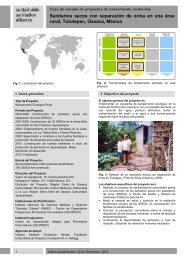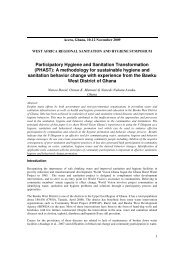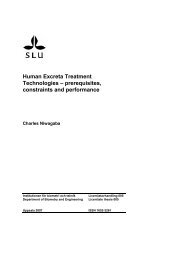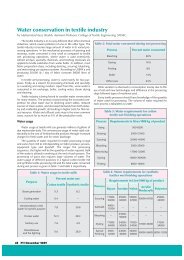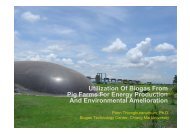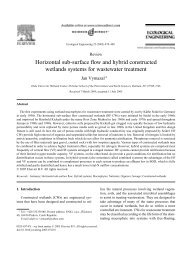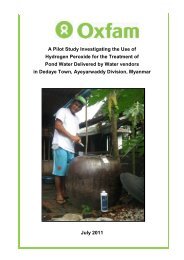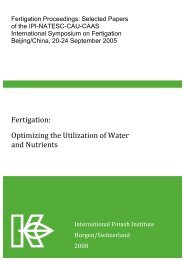qualitative water demand management for rural ... - SSWM
qualitative water demand management for rural ... - SSWM
qualitative water demand management for rural ... - SSWM
You also want an ePaper? Increase the reach of your titles
YUMPU automatically turns print PDFs into web optimized ePapers that Google loves.
daily in West Bank and most of it ends up in open dumpsites. Solid waste problem in West Bank is<br />
especially grave as a result of three main reasons; population growth rate, rising of living and<br />
consumption patterns. This situation results in an increase in the number of dumpsites to reach<br />
around 89 dumpsites (Al-Hamaidi, 1993). Because of heterogeneous nature of wastes and variations<br />
in aquifer properties, landfill sites represent a challenging opportunity to try and understand the<br />
transport and fate of waste-derived contaminants (Abu-Rukah & Al-Kofahi, 2001).<br />
The major heavy metals found in leachate included Pb, Fe, Mn, Cd , Ni and Zn while the organic<br />
compound were aromatic hydrocarbons (mainly xylenes), phenols and pesticides (kjeldsen,1992).<br />
Toxic materials and pathogenic organisms may end in ground or surface <strong>water</strong> as a result of the<br />
movement of leachate from landfills.<br />
2. PROBLEM DEFINITION<br />
The effect of hydrochemical changes of the <strong>water</strong> quality allocation sources in the West Bank<br />
should put threats to the ground<strong>water</strong> as well as surface <strong>water</strong> sources against natural and man made<br />
pollution. The <strong>qualitative</strong> changes will help to address the hydrochemical changes in order to build a<br />
related decision support system. These <strong>qualitative</strong> analyses should have the benefit <strong>for</strong> the<br />
maximized hygienic <strong>water</strong> <strong>for</strong> the people both quantitatively and <strong>qualitative</strong>ly manners and preserving<br />
the ecosystem in the area. The present study aims to assess the negative impacts of pollutants of<br />
solid waste dumpsites and the liquid wastes in some selected areas on the quality of ground<strong>water</strong>,<br />
especially the springs. This is accomplished by selecting several wells around the dumpsites and<br />
waste<strong>water</strong> wade discharge and testing their physical, chemical and biological characteristics. This<br />
study is important to reduce environmental pollutant discharge as well as to improve <strong>water</strong> quality and<br />
resources sustainability.<br />
3. BACKGROUND ABOUT THE STUDY AREA<br />
A series of aquifers and aquicludes in the West Bank are as follows: Kurnub (Kurnov) group<br />
aquiclude, Ajlun series (Judean group) aquifer, Belqa series (Mount Scoupes group) aquiclude, Jenin<br />
sub-series aquifer to aquitard and Beide and Lisan aquifer. The aquifer system in the West Bank is<br />
heterogeneous and its parameters are varying from point to point (Tahal, 1966). The aquifer system<br />
includes one upper phreatic and two lower confined aquifer systems. Ground<strong>water</strong> is found in<br />
<strong>for</strong>mations of Pleistocene to lower Cenomanian age, at depth ranging from several hundred of meters<br />
to many meters. In the area under investigation, five sub-aquifers are located within unconfined and<br />
confined strata. These aquifers are the unconfined Pleistocene, Neogene and Eocene and the<br />
confined upper and lower Cenomanian sub-aquifers. Two main structural folds are dominant in the<br />
study area, the Anabta anticline and Nablus-Beit Qad syncline. Most of the faults trend east west with<br />
some faults trending northwest southeast. Joints and karstic caves are well developed in the<br />
Bethlehem, Hebron and Jerusalem <strong>for</strong>mations.<br />
The West Bank aquifers, especially the western is considered to be sensitive from the hydrological<br />
point of view. This originates from the direct recharge of the rainfall to the ground<strong>water</strong>. The<br />
outcroppings rocks are of sedimentary rocks and composed of limestone, dolomite as well as thin<br />
laminations of marl and chalky limestone. The whole area is semi karstified and of direct effluent to<br />
the ground<strong>water</strong> bellow. The infiltration rate is higher than other areas in the West Bank and reaches<br />
in some places 26% of the rainfall.<br />
The natural outlet of the ground<strong>water</strong> in the West Bank is the springs that are spread inside the<br />
villages and the surroundings. More than 300 springs are recognized in the West Bank. The majority<br />
of these springs are suffering from the leakage of the cesspits, which are spreading in the whole area<br />
considering the major sewage system there in the absence of systematic sewage system with<br />
treatment facilities. Those springs are polluted to some extent from these cesspits in the area. This<br />
pollution is considered to be dangerous from the health point of view, in the reason that these springs<br />
are used <strong>for</strong> drinking and agricultural purposes. Water Pollution cause diseases <strong>for</strong> the inhabitants in<br />
the area.<br />
386



